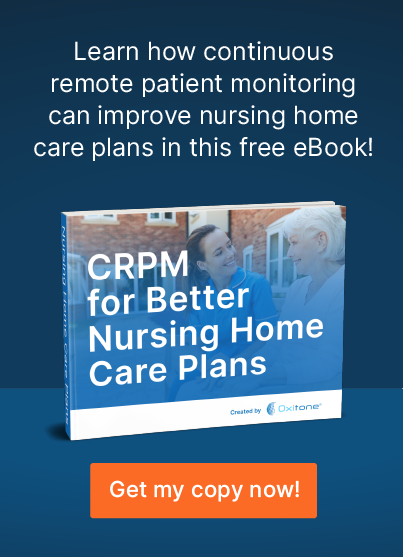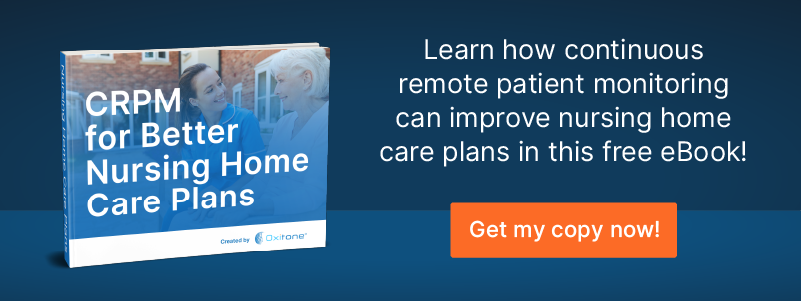Skilled nursing facilities (SNFs), or nursing homes, face a unique set of challenges due to the needs of their patient population. The elderly are more prone to accidents and certain health problems, many patients suffer from chronic diseases that require close monitoring, and the risk of infection is higher in these facilities.
Emergencies and readmissions are of special concern among this population: one in four patients discharged to an SNF from the hospital are readmitted within thirty days. With such high risks, patients and their families often have concerns about health and safety, which can significantly burden SNF employees.
Nursing home patients and their families deserve the reassurance that they are receiving the best care possible, while hospital and SNF staff need support in place to deliver high-quality care without exceeding their capacity. One support that may provide this reassurance is wireless remote patient monitoring (RPM).
Wireless RPM has the potential to improve quality of care for patients and reduce high readmission risks by enabling the closer monitoring of more patients with less time and energy consumption. By enabling care teams in hospitals and SNFs to work together on behalf of the patients, wireless remote patient monitoring has the power to transform nursing home care.
The Role of Wireless Remote Patient Monitoring in Nursing Homes
Nursing home patients and caretakers deal with a distinct set of risks and challenges. Many of these obstacles can be mitigated with the implementation of wireless RPM in SNFs.
A primary concern in SNFs is the risk of infection among their populations. Approximately 26% of adverse events are infection related, posing the risk of hospital admissions and readmissions. Wireless remote patient monitoring enables the continuous monitoring of signs of infection, which can help reduce the spread of infections.
The COVID-19 pandemic offers a prime example of how SNFs can utilize RPM to control infection risk. During the pandemic, RPM was especially effective for nursing facilities like TRU Community Care, which used it to help patients feel safer and more connected to the outside world, despite an unprecedented infection risk.
Another crucial challenge for SNFs is capacity—namely, their ability to accept new patients based on the care needs of current residents. Long-term care demand is expected to double in the upcoming years due to an aging population and the increased prevalence of chronic conditions.
Many SNFs already have difficulty keeping up with this demand due to constraints on the availability of physical space and staff attention. However, experts predict that the use of RPM in the future will make the process of delivering long-term care more efficient for patients and staff.
By tracking important care metrics, RPM enables the creation of predictive models of who is likely to move out of SNFs and into a higher level of care, so these facilities can accurately estimate their capacity to accept new patients. By freeing up caretakers’ time and energy, RPM may also increase the capacity of staff to care for new and existing patients in SNFs.
Additionally, RPM helps SNF staff members better serve the unique medical needs of the aging population. In particular, cognitive decline is a leading reason that families seek SNF care for their elderly loved ones. Even normal forgetfulness can lead to poor management of chronic disease, causing more medical emergencies, admissions, and readmissions.
Currently, caretakers must juggle dozens of patients’ chronic disease care, including complicated medication regimens. RPM devices with smart features like medication alarms can reduce forgetfulness without the need for staff intervention, driving down labor costs and freeing up more time to provide better care to patients who need increased attention.
How Oxitone Can Improve Nursing Home Care
Oxitone 1000M is a device that falls into an exciting new category of RPM tools utilizing advanced medical-grade technology to provide hospital-quality care to patients at home or in an SNF. The device can be worn by patients to monitor important parameters while minimizing the time and costs associated with chronic disease management.
Oxitone 1000M is an FDA-cleared medical monitor that has the ability to continuously monitor vital signs like blood oxygen, heart rate and variability, and respiratory rate. Additionally, it offers providers access to continuous data on sleep and behavior, as well as COVID-19 symptom monitoring.
To minimize the burden on SNF caretakers, Oxitone 1000M only generates smart signals when this data warrants further attention by providers, reducing the need for ongoing attention to monitoring. These smart signals enable staff to intervene before variances in data can become medical emergencies or readmissions. Oxitone 1000M reduces the time and cost burden on healthcare providers.
WIth Oxitone 1000M, patients and their families receive the much-needed reassurance that their loved ones are being closely monitored for changes in their health status. Likewise, staff can rest easy knowing that their capacity to care for patients, especially those with demanding care needs, has increased due to their SNF’s reliance on Oxitone 1000M.
Here at Oxitone, we boost value-based healthcare by delivering extraordinary patient, clinical, and economical outcomes at reduced medical utilization and cost. Patients need a prompt response to emergencies. Physicians need an easy and timely follow-up with patients. Our mission is to transform chronic disease management and help save lives worldwide.
Let’s save lives together! To see how we help remote patient monitoring companies and physicians improve the management and care of high-risk patients, contact us today!


